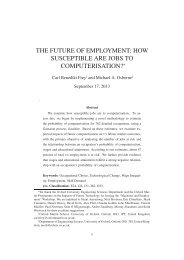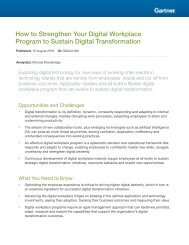THE FUTURE OF EMPLOYMENT: HOW SUSCEPTIBLE ARE JOBS TO COMPUTERIZATION?
We examine how susceptible jobs are to computerization. To assess this, we begin by implementing a novel methodology to estimate the probability of computerization for 702 detailed occupations, using a Gaussian process classifier. Based on these estimates, we examine expected impacts of future computerization on US labor market outcomes, with the primary objective of analyzing the number of jobs at risk and the relationship between an occupation’s probability of computerization, wages and educational attainment. According to our estimates, about 47 percent of total US employment is at risk. We further provide evidence that wages and educational attainment exhibit a strong negative relationship with an occupation’s probability of computerization.
We examine how susceptible jobs are to computerization. To assess this, we begin by implementing a novel methodology to estimate the probability of computerization for 702 detailed occupations, using a Gaussian process classifier. Based on these estimates, we examine expected impacts of future computerization on US labor market outcomes, with the primary objective of analyzing the number of jobs at risk and the relationship between an occupation’s probability of computerization, wages and educational attainment. According to our estimates, about 47 percent of total US employment is at risk. We further provide evidence that wages and educational attainment exhibit a strong negative relationship with an occupation’s probability of computerization.
Create successful ePaper yourself
Turn your PDF publications into a flip-book with our unique Google optimized e-Paper software.
sure the offshorability or automatability of jobs. Accordingly, Blinder (2009)<br />
finds that past attempts to create objective offshorability rankings using O∗NET<br />
data have yielded some questionable results, ranking lawyers and judges among<br />
the most tradable occupations, while classifying occupations such as data entry<br />
keyers, telephone operators, and billing clerks as virtually impossible to move<br />
offshore.<br />
To work around some of these drawbacks, we combine and build upon the<br />
two described approaches. First, together with a group of ML researchers, we<br />
subjectively hand-labelled 70 occupations, assigning 1 if automatable, and 0<br />
if not. For our subjective assessments, we draw upon a workshop held at the<br />
Oxford University Engineering Sciences Department, examining the automatability<br />
of a wide range of tasks. Our label assignments were based on eyeballing<br />
the O∗NET tasks and job description of each occupation. This information is<br />
particular to each occupation, as opposed to standardised across different jobs.<br />
The hand-labelling of the occupations was made by answering the question<br />
“Can the tasks of this job be sufficiently specified, conditional on the availability<br />
of big data, to be performed by state of the art computer-controlled equipment”.<br />
Thus, we only assigned a 1 to fully automatable occupations, where<br />
we considered all tasks to be automatable. To the best of our knowledge, we<br />
considered the possibility of task simplification, possibly allowing some currently<br />
non-automatable tasks to be automated. Labels were assigned only to<br />
the occupations about which we were most confident.<br />
Second, we use objective O∗NET variables corresponding to the defined<br />
bottlenecks to computerisation. More specifically, we are interested in variables<br />
describing the level of perception and manipulation, creativity, and social<br />
intelligence required to perform it. As reported in Table I, we identified nine<br />
variables that describe these attributes. These variables were derived from the<br />
O∗NET survey, where the respondents are given multiple scales, with “importance”<br />
and “level” as the predominant pair. We rely on the “level” rating which<br />
corresponds to specific examples about the capabilities required of computercontrolled<br />
equipment to perform the tasks of an occupation. For instance, in<br />
relation to the attribute “Manual Dexterity”, low (level) corresponds to “Screw<br />
a light bulb into a light socket”; medium (level) is exemplified by “Pack oranges<br />
in crates as quickly as possible”; high (level) is described as “Perform<br />
open-heart surgery with surgical instruments”. This gives us an indication of<br />
30





